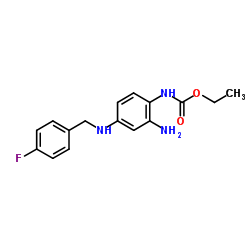Ezogabine (retigabine) and its role in the treatment of partial-onset seizures: a review.
Michele Y Splinter
文献索引:Clin. Ther. 34(9) , 1845-56.e1, (2012)
全文:HTML全文
摘要
Ezogabine, also known as retigabine, is a recently approved anticonvulsant medication with a novel mechanism of action. It activates low-threshold voltage-gated potassium channels, leading to hyperpolarization of the membrane potential, stabilization of the resting membrane potential, and suppression of repetitive firing.This review identified the efficacy and tolerability of ezogabine in the treatment of partial-onset seizures reported in randomized controlled trials. Additional characteristics of the medication, including mechanism of action, pharmacokinetic properties, drug interactions, and additional applications under investigation are also addressed.MEDLINE and EMBASE were systematically searched, using the search terms retigabine and ezogabine, for randomized trials published from 1980 through February 8, 2012. Trials of the effects of adjunctive ezogabine in patients aged ≥16 years with partial seizures were included for analysis of clinical efficacy and tolerability. Articles that did not pertain to clinical efficacy and that did not report on randomized controlled trials were excluded. Articles relating to additional properties were reviewed for inclusion in the review.One Phase IIb and 2 Phase III trials were identified. Ezogabine has reported dose-dependent efficacy at doses of 600, 900, and 1200 mg/d. As with most anticonvulsant medications, the most common adverse events associated with ezogabine were central nervous system effects. Because potassium channels in the urothelium of the bladder are activated by ezogabine, a Risk Evaluation and Mitigation Strategy is in place regarding the risk for urinary retention and symptoms of acute urinary retention. There are limited drug interactions with ezogabine because it does not undergo metabolism by the cytochrome P450 system and is not highly protein bound.Ezogabine is a newly approved anticonvulsant for adjunctive therapy in partial-onset seizures in adults with a novel mechanism of action, activating low-threshold voltage-gated potassium channels. It has advantages over many of the available anticonvulsants in that it is not metabolized through the cytochrome P450 system and is not highly protein bound, therefore limiting its potential for drug-drug interactions. Unique to ezogabine compared with other anticonvulsants is its association with urinary retention due to its effect on potassium channels in the urothelium of the bladder.Copyright © 2012 Elsevier HS Journals, Inc. All rights reserved.
相关化合物
| 结构式 | 名称/CAS号 | 分子式 | 全部文献 |
|---|---|---|---|
 |
瑞替加滨
CAS:150812-12-7 |
C16H18FN3O2 |
|
Enhanced in vitro CA1 network activity in a sodium channel β...
2014-04-01 [Epilepsia 55(4) , 601-8, (2014)] |
|
Safety profile of two novel antiepileptic agents approved fo...
2013-11-01 [Expert Opin. Drug Saf. 12(6) , 847-55, (2013)] |
|
[Retigabine - a new antiepileptic drug with a different mech...
2013-01-01 [Postepy. Hig. Med. Dosw. 67 , 973-81, (2013)] |
|
P-retigabine: an N-propargyled retigabine with improved brai...
2015-01-01 [Mol. Pharmacol. 87(1) , 31-8, (2015)] |
|
[Retigabine. A novel anticonvulsant drug for the adjunctive ...
2012-05-01 [Med. Monatsschr. Pharm. 35(5) , 166-71, (2012)] |